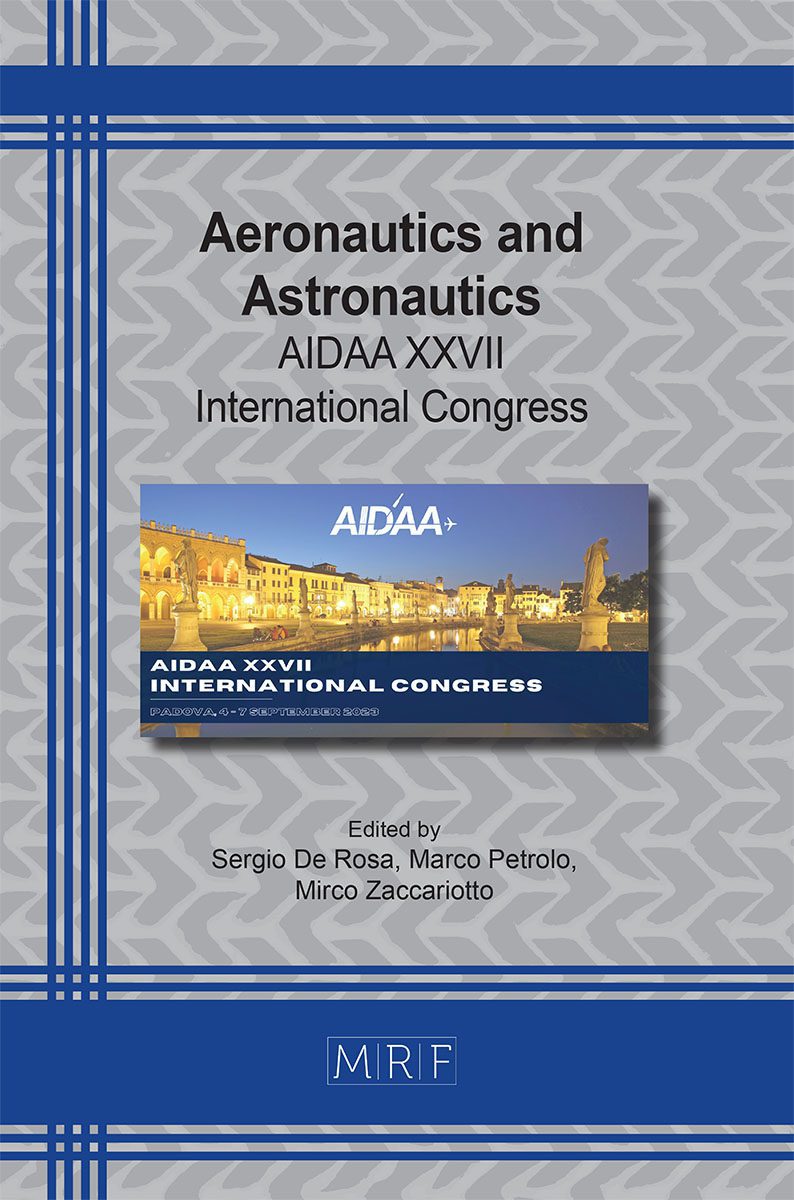Thermite-for-demise (T4D): thermite characteristics heuristic optimization on object- and spacecraft-oriented re-entry models
Alessandro Finazzi, Filippo Maggi, Tobias Lips
download PDFAbstract. The major hazard associated with uncontrolled atmospheric re-entry is the casualty risk on ground. An innovative concept to support spacecraft demise that is now under investigation is the use of exothermic reactions. Thermites are good candidates for this role, being capable of releasing a noticeable amount of heat upon ignition. An appropriate selection of the metal-metal oxide couple can grant a formulation that is compliant with the main space operation needs, e.g., that is relatively insensitive to external stimuli and non-toxic. To support the selection of the energetic material for the experimental tests in the ESA-founded project SPADEXO and to preliminarily size the charge to be placed on board, the object-oriented code TRANSIT has been developed. This software has been compared to ESA’s spacecraft-oriented code SCARAB (developed by HTG), that is capable to predict spacecraft re-entry with the highest possible level of detail. Both the models were subjected to a genetic algorithm optimization process to identify the best thermite properties and the foreseen energetic material mass for simple geometries applications. In this paper, the SCARAB results obtained for one geometry will be presented and compared with the ones retrieved by TRANSIT.
Keywords
Atmospheric Re-Entry, Genetic Algorithm, Thermite, Spacecraft Demise
Published online 11/1/2023, 4 pages
Copyright © 2023 by the author(s)
Published under license by Materials Research Forum LLC., Millersville PA, USA
Citation: Alessandro Finazzi, Filippo Maggi, Tobias Lips, Thermite-for-demise (T4D): thermite characteristics heuristic optimization on object- and spacecraft-oriented re-entry models, Materials Research Proceedings, Vol. 37, pp 668-674, 2023
DOI: https://doi.org/10.21741/9781644902813-144
The article was published as article 144 of the book Aeronautics and Astronautics
![]() Content from this work may be used under the terms of the Creative Commons Attribution 3.0 license. Any further distribution of this work must maintain attribution to the author(s) and the title of the work, journal citation and DOI.
Content from this work may be used under the terms of the Creative Commons Attribution 3.0 license. Any further distribution of this work must maintain attribution to the author(s) and the title of the work, journal citation and DOI.
References
[1] AA. VV., ESA’s Annual Space Environment Report. Issue 6. European Space Agency Space Debris Office. Darmstadt, Germany. (2023).
[2] AA. VV., IADC Report on the Status of the Space Debris Environment. Issue 1, Revision 0. Inter-Agency Space Debris Coordination Committee. (2023).
[3] AA. VV., IADC Space Debris Mitigation Guidelines. Revision 2. Inter-Agency Space Debris Coordination Committee. (2020).
[4] AA. VV., Tri-Agency Reliability Engineering Guidance: Post Mission Disposal and Extension Assessment. ESA-TECQQD-TN-025375 / CAA-2021025 / NASA/SP-20210024973. ESA, JAXA, and NASA. (2022).
[5] AA.VV., Final Report – Upgrade of DRAMA’s Spacecraft Entry Survival Analysis Codes. Contract No. 4000115057/15/D/SR. Issue 3, Revision 1.0.2. Hyperschall Technologie Göttingen GmbH. (2019).
[6] Koppenwallner, G., B. Fritsche, T. Lips and H. Klinkrad, SCARAB – A multi-disciplinary code for destruction analysis of space-craft during re-entry. In: 5th European Symposium on Aerothermodynamics for Space Vehicles. Cologne, Germany. (2005).
[7] Fischer, S.H. and N.C. Grubelich, Theoretical Energy Release of Thermites, Intermetallics, and Combustible Metals. 24th International Pyrotechnics Seminar. Monterey, CA. (1998). https://doi.org/10.2172/658208
[8] Finazzi, A., F. Maggi, L. Galfetti, C. Paravan, S. Dossi, A. Murgia, T. Lips, G. Smet, Thermite-for-Demise (T4D): Material selection for exothermic reaction-aided spacecraft demise during re-entry. In : 2nd International Conference on Flight Vehicles, Aerothermodynamics and Re-entry Missions & Engineering (FAR). Heilbronn, Germany. (2022).
[9] Dihlan, D., and P. Omaly, Élement de véhicule spatial a capacité d’autodestruction ameliorée et procedure de fabrication d’un tel elément. Patent FR 2975080B1. (2011).
[10] Seiler, R., and G. Smet, Exothermic reaction aided spacecraft demise during re-entry. Patent EP 3604143A1. (2018).
[11] Monogarov, K.A., A.N. Pivkina, L.I. Grishin, Yu.V. Frolov and D. Dilhan, Uncontrolled re-entry of satellite parts after finishing their mission in LEO: Titanium alloy degradation by thermite reaction energy. Acta Astronautica. 135:69-75. (2017). https://doi.org/10.1016/j.actaastro.2016.10.031
[12] Schleutker, T., A. Gülhan., B. Esser, and T. Lips., ERASD – Exothermic Reaction Aided Spacecraft Demise – Proof of Concept Testing. Test Report. DLR, Supersonic and Hypersonic Technologies Department. (2019).
[13] Maggi, F., A. Finazzi, P. Finocchi, C. Paravan, L. Galfetti, S. Dossi, A. Murgia, T. Lips, G. Smet, K. Bodjona, Thermite-for-Demise: Preliminary on-Ground Heat Transfer Experimental Testing. In: AIAA SCITECH 2023 Forum. National Harbor, MD & Online. (2023). https://doi.org/10.2514/6.2023-1778
[14] J.M. Picone, A.E. Hedin, D.P. Drob and A.C. Aikin, NRL-MSISE-00 Empirical Model of the Atmosphere: Statistical Comparisons and Scientific Issues, J. Geophys. Res., Vol. 107, Issue A12, SIA 15-1:15-16. (2003). https://doi.org/10.1029/2002JA009430
[15] A. Tewari, Atmospheric and Space Flight Dynamics – Modeling and Simulation with MATLAB and Simulink, Birkhäuser, Boston. (2007).
[16] M. Trisolini, Space System Design for Demise and Survival, PhD Thesis, University of Southampton, Faculty of Engineering and the Environment, Department of Astronautics. (2018).
[17] R.D. Klett, Drag coefficients and heating ratios for right circular cylinders in free-molecular and continuum flow from Mach 10 to 30, Report SC-RR-64-2141, Sandia Laboratory, Albuquerque. (1964). https://doi.org/10.2172/4630398
[18] J.A. Fay and F.R. Riddel, Theory of stagnation point heat transfer in dissociated air, Journal of the Aerospace Sciences, Vol. 25, No.2, 73:85. (1958). https://doi.org/10.2514/8.7517
[19] J.D. Anderson Jr, Hypersonic and high temperature gas dynamics, American Institute of Aeronautic and Astronautics, 2nd edition, Reston, Virginia, USA. (2006). https://doi.org/10.2514/4.861956
[20] A.F. Gad, PyGAD: An Intuitive Genetic Algorithm Python Library, arXiv 2106.06158. (2021).
[21] Anon., European Space maTerIal deMisability dATabasE [Online], European Space Agency. https://estimate.sdo.esoc.esa.int/ . Last access: 10/06/2023.































